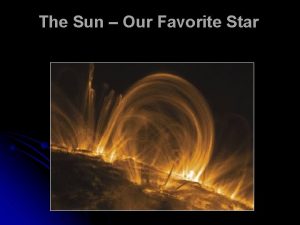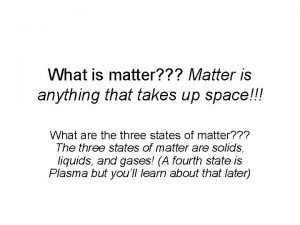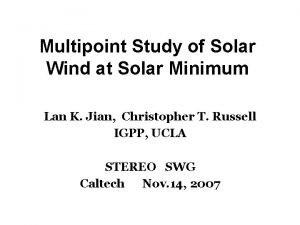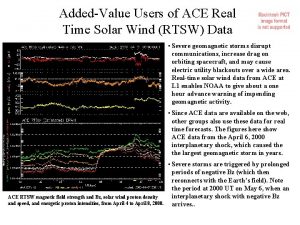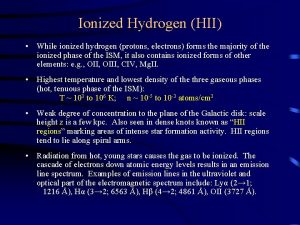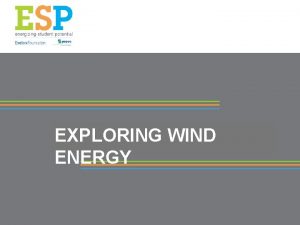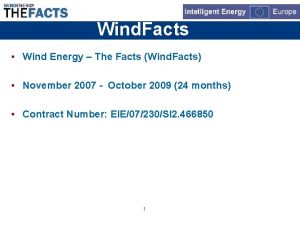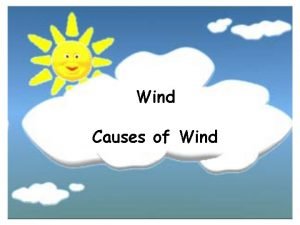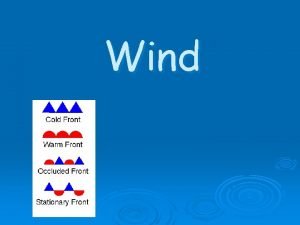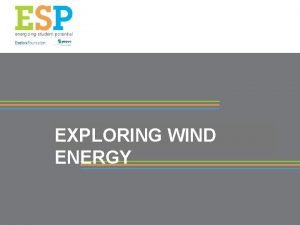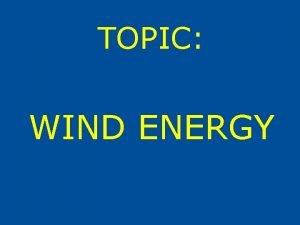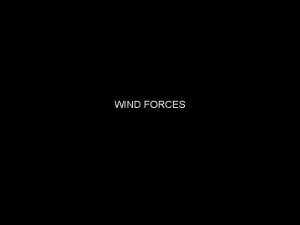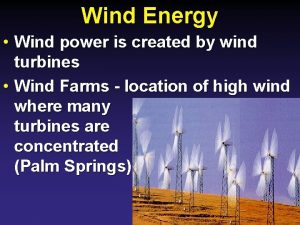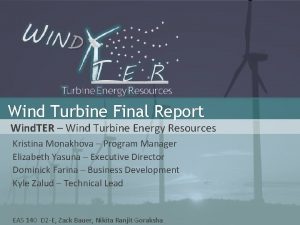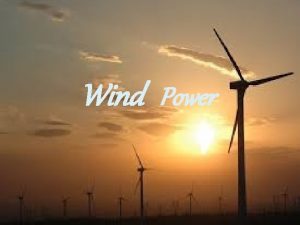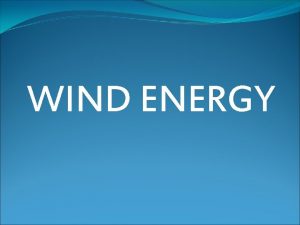The Solar Wind The solar wind is ionized















![The Solar Wind is Highly Variable – V[m/s] fast streams Historical Note: Recent observations The Solar Wind is Highly Variable – V[m/s] fast streams Historical Note: Recent observations](https://slidetodoc.com/presentation_image_h2/393b29584577beb315baba7be0847940/image-16.jpg)































- Slides: 47

The Solar Wind The solar wind is ionized gas emitted from the Sun flowing radially outward through the solar system and into interstellar space. The solar wind is the extension of the solar corona to very large heliocentric distances. 1

Solar Atmosphere Solution 2

3

• The Earth’s atmosphere is stationary. The Sun’s atmosphere is not static but is blown out into space as the solar wind filling the entire heliosphere. • The first direct measurements of the solar wind were in the 1960’s but it had already been suggested in the early 1900 s. – To explain a correlation between auroras and sunspots Birkeland [1908] suggested continuous particle emission from these spots. – Others suggested that particles were emitted from the Sun only during flares and that otherwise space was empty [Chapman and Ferraro, 1931]. – Observations of comet tails lead to the suggestion of a continuous solar wind. – The question of a continuous solar wind was resolved in 1962 when the Mariner 2 spacecraft returned 3 months of continuous solar wind data while traveling to Venus. 4

5

Solar Wind Solution • The solar wind exists because the Sun maintains a 2 x 106 K corona as its outer most atmosphere. The Sun’s atmosphere “boils off” into space and is accelerated to high velocities (> 400 km s-1). Parker [1958] proposed that the solar wind was the result of the high temperature corona and developed a hydrodynamic model to support his idea. Based on this Dessler developed a simple gravitational nozzle which demonstrates the basic physics. • • – Simplifying assumptions: 1. The solar wind can be treated as an ideal gas. 2. The solar wind flows radially from the Sun. 3. Acceleration due to electromagnetic fields is negligible. 4. The solution is time stationary (i. e. the time scale for solar wind changes is long compared to the time scale for solar wind generation). 6

1. Conservation of mass - 2. Conservation of momentum - 3. Speed of sound - Combining (1), (2), (3) gives If and then 7

• The transition from subsonic to supersonic occurs at a critical radius rc where • In order for a real continuous solution to exist at rc • The form of solutions for the expansion of the solar wind • Solution A is the “observed” solar wind. It starts as a subsonic flow in the lower corona and accelerates with increasing radius. At the critical point the solar wind becomes supersonic. • For solution F the speed increases only weakly with height and the critical velocity is not reached. For this case the solar wind is a “solar breeze”. • For solution C the flow accelerates too fast, becomes supersonic before reaching the critical radius and turns around and flows into the Sun. 8

• Solution B starts as a supersonic flow in the lower corona and becomes subsonic at the critical point. • If the flow decelerates less as in D it would still be supersonic at the critical point and be accelerated again. • Solution E is an inward blowing wind that is subsonic. The flow accelerates as it approaches the Sun, turns back and leaves the Sun supersonically. • Quantitative solutions (after Parker [1958]) 9

• For the solar wind to continue to accelerate then the mean thermal energy must exceed the gravitational energy. • To have a solar wind a star must have a cool lower atmosphere and a hot outer atmosphere. • How is the corona heated? – Assume an ideal gas where = ration of specific heats. – If there is no heat gain or loss then the system is adiabatic and – – Taking the spatial derivative of we find 10

• Solving Where is the density at the base of the atmosphere r 0. • From the conservation of mass we get • These two conditions cannot be solved for and therefore the lower atmosphere can’t be adiabatic. • Heat must be supplied from the cooler stellar surface! 11

• In summary the outer layer of the solar atmosphere will accelerate outward provided a suitable heating source adds enough energy to overcome the Sun’s gravitational energy. • There is a limit to how hot the atmosphere can be and still produce a supersonic solar wind! – For an ideal gas and where m is the mass of the gas particles. – Using this the equation for the solar wind expansion becomes – For very hot stars the numerator is always positive and the denominator is negative so that as the atmosphere expands the velocity decreases and never becomes supersonic. – For cool stars both numerator and denominator start negative and flow accelerates outward. At some time v approaches the sonic velocity. At this point the acceleration will only continue if thermal energy exceeds the gravitational energy. 12

• The most detailed observations of the solar wind have been made from spacecraft near the Earth. Observed Properties of the Solar Wind near the Orbit of the Earth (after Hundhausen, [1995]) Proton density 6. 6 cm-3 Electron density 7. 1 cm-3 He 2+ density 0. 25 cm-3 Flow speed (nearly radial) 450 km s-1 Proton temperature 1. 2 x 105 K Electron temperature 1. 4 x 105 K Magnetic field 7 x 10 -9 T 13

• It is useful to describe the solar wind in terms of quantities that are conserved in the plasma flow. Flux Through a Sphere at 1 AU (after Hundhausen, [1995]) Protons 8. 4 x 1035 s-1 Mass 1. 6 x 1012 g s-1 Radial momentum 7. 3 x 1014 N (Newton) Kinetic energy 1. 7 x 1027 erg s-1 Thermal energy 0. 05 x 1027 erg s-1 Magnetic energy 0. 025 x 1027 erg s-1 Radial magnetic flux 1. 4 x 1015 Wb (Weber) 14

• The solar wind speed and density have large variations on time scales of days. Of special interest are high speed streams. – The flow speed varies from pre-stream levels (400 km/s) reaching a maximum value (600 km/s – 700 km/s) in about one day. – The density rises to high values (>50 cm-3) near the leading edges of the streams and these high densities generally persist for about a day. The peaks are followed by low densities lasting several days. – The proton temperature varies like the flow speed. – The high speed streams tend to have a dominant magnetic polarity. – The dominant source of high speed streams is thought to be field lines that are open to interplanetary space. These regions are known as coronal holes. 15
![The Solar Wind is Highly Variable Vms fast streams Historical Note Recent observations The Solar Wind is Highly Variable – V[m/s] fast streams Historical Note: Recent observations](https://slidetodoc.com/presentation_image_h2/393b29584577beb315baba7be0847940/image-16.jpg)
The Solar Wind is Highly Variable – V[m/s] fast streams Historical Note: Recent observations shock The solar wind was first sporadically detected by the Soviet space probes Lunik 2 and 3. 16

Solar Wind Statistics “slow” “fast” 17

• In summary the outer layer of the solar atmosphere will accelerate outward provided a suitable heating source adds enough energy to overcome the Sun’s gravitational energy. • There is a limit to how hot the atmosphere can be and still produce a supersonic solar wind! – For an ideal gas and where m is the mass of the gas particles. – Using this the equation for the solar wind expansion becomes – For very hot stars the numerator is always positive and the denominator is negative so that as the atmosphere expands the velocity decreases and never becomes supersonic. – For cool stars both numerator and denominator start negative and flow accelerates outward. At some time v approaches the sonic velocity. At this point the acceleration will only continue if thermal energy exceeds the gravitational energy. 18

• Intermixed with the outflowing solar wind is a weak magnetic field – the interplanetary magnetic field (IMF). – On the average the IMF is in the ecliptic plane at the orbit of the Earth although at times it can have substantial components perpendicular to the ecliptic. – The hot coronal plasma has extremely high electrical conductivity and the IMF becomes “frozen in” to the flow. – If the Sun did not rotate the resulting magnetic configuration would be very simple: magnetic field lines stretching radially from the Sun. – The Sun rotates with a sidereal rotation period of 27 days. – As the Sun rotates the base of the field line frozen into the plasma rotates westward turning the radial field lines into an Archimedean spiral. 19

Loci of a succession of fluid parcels (eight of them in this sketch) emitted at a constant speed from a source fixed on the rotating Sun. Loci of a succession of fluid particles emitted at constant speed from a source fixed on the rotating Sun. 20

• Assume a plasma parcel on the Sun at a source longitude of source radius of r 0. – At time t the parcel will be found at the position and a and – Eliminating the time gives 21

• Let us express the magnetic field in the equatorial plane in polar coordinates as – Gauss’s Law in spherical coordinates is since the field depends only on r so that. – The magnetic flux through radial shells is conserved and the radial component of the field decreases as – The frozen-in field condition or If we assume that gives is radial at r 0 we get 22

– At large distances and . – The radial component falls off as r-2 while the azimuthal component falls off as r-1. • The angle between the magnetic field direction and the radius vector from the Sun is. For typical solar wind parameters at the Earth it is about 450 with respect to the radial direction. • The stretched out heliospheric configuration is maintained by an equatorial current sheet. The magnetic field lines and current lines are plotted below. 23

• The IMF can be directed either inward or outward with respect to the Sun. • One of the most remarkable observations from early space exploration was that the magnetic field polarity was uniform over large angular regions and then abruptly changed polarity. – This polarity pattern repeated over succeeding solar rotations. The regions of one polarity are called magnetic sectors. – In a stationary frame of reference the sectors rotate with the Sun. – Typically there about four sectors. – The sector structure gets very complicated during solar maximum. 24

• The sector structure inferred from IMP satellite observations. Plus signs are away from the Sun and minus signs are toward the Sun. 25

THE INTERPLANETARY MEDIUM AND IMF Intermixed with the streaming solar wind is a weak magnetic field, the IMF. The solar wind is a “high-b” plasma, so the IMF is "frozen in”; the IMF goes where the plasma goes. Consequently, the "spiral" pattern formed by particles spewing from a rotating sun is also manifested in the IMF. The field winds up because of the rotation of the sun. Fields in a low speed wind will be more wound up than those in high speed wind. 26

• Until the 1990’s our knowledge of the heliosphere was limited to the ecliptic. • The Ulysses spacecraft observed flow over both the northern and southern poles of the Sun. • No latitudinal gradient in Br. – Magnetic flux is removed from the poles toward the equatorial regions. – Sketch showing equatorial current sheet and magnetic field lines coming from the polar regions toward the equator. [Smith et al. , 1978] 27

Magnetic-field lines deduced from the isothermal MHD coronal expansion model of Pneuman and Kopp (1971) for a dipole field at the base of the corona. The dashed lines are field lines for the pure dipole field. MHD modeling shows that the inner magnetic field lines (R < 2) near the equator are closed, and that at higher latitudes the field lines are drawn outward and do not close. These field lines that do not close nearly meet at low latitudes, but do not reconnect; this abrupt change in the magnetic field polarity is maintained by a thin region of high current density called the interplanetary current sheet. This current sheet separates the plasma flows and fields that originate from opposite ends of the dipole-like field. 28

• Plasma measurements show a dramatic change in velocity with latitude in observations taken between 1992 and 1997. [Mc. Comas et al. , 1998]. – The velocity increases from about 450 km/s at the equator to about 750 km/s above the poles. – Above 500 only fast solar winds streaming out of coronal holes were observed. – Up to about 300 a recurrent CIR was observed with a period of about 26 days. – Near the equator, the curvature force due to the magnetic field reduces the solar wind speed. 29

Plasma leaves the sun predominantly at high latitudes and flows out and towards the equator where a current sheet is formed corresponding to the change in magnetic field polarity. The Sun’s magnetic field is dragged out by the high-beta solar wind. The current sheet prevents the oppositely-directed fields from reconnecting. The current sheet is tilted with respect to the ecliptic (about 7°), ensuring that earth will intersect the current sheet at least twice during each solar rotation. This gives the appearance of "magnetic sectors". 2 3 1 j 1976 (max 1979) 1986 1998 (max 2001) 2008 30

• That the IMF has sector structure suggests that plasma in a given sector comes from a region on the Sun with similar magnetic polarity. • The sector boundaries are an extension of the “neutral line” associated with the heliospheric current sheet (HCS). – The dipolar nature of the solar magnetic field adds latitudinal structure to the IMF. – The radial magnetic field has one sign north of the HCS and one sign south of the HCS. – The current sheet is inclined by about 70 to the rotational equator. – As the Sun rotates the equator moves up and down with respect to the solar equator so that the Earth crosses the equator twice a rotation. [From Kallenrode, 1998]. 31

Wavy Structure of the Interplanetary Current Sheet Where Earth’s orbit intersects this current sheet determines whether Earth “sees” a positive or negative magnetic sector. 32

Two Classes of Solar Particle Events 33

• • • The Archimedean spiral associated with slow streams is curved more strongly than for a fast stream. Because field lines are not allowed to intersect at some point an interaction region develops between fast and slow streams. Since both rotate with the Sun these are called corotating interaction regions (CIR). On the Sun there is an abrupt change in the solar wind speeds but in space the streams are spread out. At the interface between fast and slow streams the plasma is compressed. The characteristic propagation speeds (the Alfven speed and the sound speed) decrease. At some distance between 2 AU and 3 AU the density gradient on both sides of the CIR becomes large and a pair of shocks develop. • The shock pair propagate away from the interface. – The shock propagating into the slow speed stream is called a forward shock. – The shock propagating into the fast wind is called a reverse shock. 34

• Changes in the solar wind plasma parameters (speed V, density N, proton and electron temperatures TP and TE, magnetic-field intensity B, and plasma pressure P) during the passage of an interplanetary shock pair past the ISEE 3 spacecraft. [Hundhausen, 1995]. 35

Acceleration of High-Energy Particles: Near the Sun & in Interplanetary Shocks The measured spectra of energetic particles near Earth indicate 2 spectral regimes. The time history indicates the high-energy component was accelerated near the Sun, and the low-energy component in interplanetary space, probably in association with shocks. 36

• Coronal mass ejections in interplanetary space still carry the magnetic signature of the filament that formed them on the Sun. – These closed magnetic field structures are called magnetic clouds. – Magnetic and plasma data from a magnetic cloud. Magnetic field magnitude, elevation, azimuth, solar wind speed, plasma density, and proton temperature. [Burlaga, 1991] – Decrease in B in the cloud. – Rotation of the magnetic field vector. – Decreases in the density, plasma speed, and plasma temperature 37

• The magnetic field configuration of a magnetic cloud can be inferred from the variation in the elevation. – At the beginning of the event the field is perpendicular to the ecliptic plane. – After the cloud has passed the field has almost reversed direction. – This is an indication of a magnetic field wrapped around the structure – sometimes called a flux rope. – The orientation of the magnetic cloud (i. e. whether is it north then south or vice versa depends on the field at the source). – How long the cloud stays connected to the Sun is not known. – Magnetic clouds are the main cause of geomagnetic disturbances called magnetic storms at Earth. 38

Coronal Holes and Solar Wind Speed and Density The interplay between the inward pointing gravity and outward pointing pressure gradient force results in a rapid outward expansion of the coronal plasma along the open magnetic field lines. At low latitudes the direction of the coronal magnetic field is far from radial. Therefore the plasma cannot leave the vicinity of the Sun along magnetic field lines. At the base of low-latitude coronal holes, however, the magnetic field direction is not far from radial, and the expansion of the hot plasma can take place along open magnetic field lines without much resistance fast solar wind. 39

• The heliospheric current sheet shows marked variation during the solar cycle. – The “waviness” of the current sheet increases at solar maximum. – The current sheet is rather flat during solar minimum but extends to high latitudes during solar maximum. – During solar minimum CIRs are confined to the equatorial region but cover a wide range of latitudes during solar maximum. – The average velocity of the solar wind is greater during solar minimum because high-speed streams are observed more frequently and for longer times 40

How does the corona acquire the necessary energy for the mean thermal energy of the coronal gas to increase outward from the sun and overcome the sun's gravity ? A source of coronal heating is required. Four possibilities have been suggested: • • Acoustic wave dissipation Alfven wave dissipation MHD wave dissipation Microflares “magnetic carpet” The currently favored mechanism, evolved from multi-instrument observations from SOHO, is that “short-circuit” electric currents flowing in the loops of the “magnetic carpet”, and extending into the corona, provide the energy necessary to raise the coronal temperatures to millions of degrees K. Microflares are thought to accompany these intense currents. 41

Small magnetic loops permeate the surface of the Sun, much like a magnetic carpet Each loop carries as much energy as a large hydroelectric plant (i. e. , Hoover Dam) generates in about a million years ! More sensitive instruments are needed to actually observe the microflares thought to exist. Energy flows from the loops when they interact, producing electrical and magnetic “short-circuits”. The very strong currents in these short circuits are what heats the corona to high temperatures. 42

• Waves and turbulence? – One possibility is that the corona is heated by compressional waves at or just below the surface. Oscillatory motion of the Sun’s surface could drive pressure waves. In theory fast mode waves could propagate up to 20 RSun. Experiments designed to detect sound waves propagating into the corona have not detected them. • Impulsive energy release? – The Sun has a magnetic field that contains magnetic energy. Magnetic energy can be converted into thermal energy. This is done by reconnection. The granularity of the photosphere as the top of the convection zone is caused by bubbles rising and falling. These might reconnect. X-ray bursts may be evidence of this happening. • We still don’t know how the corona is heated! 43

The Heliosphere and its Interaction with the Interstellar Medium Heliopause Interstellar Medium Termination Shock Heliosphere Heliospheric Bow Shock ? The heliosphere and heliopause represent the region of space influenced by the Sun and its expanding corona, and in some respects encompass the true extent of the solar system. 44

The radially-expanding supersonic solar wind must be somehow diverted to the downstream direction to merge with the flow of the interstellar medium. This diversion can only take place in subsonic flow, and therefore the supersonic expansion of the solar wind must be terminated by an “inner shock” or “termination shock”. Flow lines of the interstellar plasma do not penetrate into the region dominated by the solar wind flow but flow around a “contact surface” called the heliopause, which is considered to be the outer boundary of the heliosphere. The interstellar medium (ISM) will form a heliospheric bow shock if it is supersonic with respect to the heliopause 26 km/sec 45

• The solar wind forms a bubble, called the heliosphere, in the partially ionized local interstellar medium (LISM). • We do not know if the LISM is subsonic – the LISM flow will be diverted around the heliospheric obstacle either adiabatically or by forming a bow shock. • The boundary separating the heliosphere from the LISM is the heliopause (HP). • The solar wind is supersonic and a shock (the termination shock-TS) forms within the heliosphere as it approaches the heliopause. • The region of shocked plasma between the TS and the heliopause is called the inner heliosheath. • In the simulation below the LISM flow was assumed to be supersonic and no interstellar neutral hydrogen was assumed. Contours of temperature and flow streamlines- from Zank et 46 al. , 2001

47
 Prominences are ionized gases trapped by
Prominences are ionized gases trapped by Ionized wet scrubber
Ionized wet scrubber Ionized matter
Ionized matter Raumschotkurs
Raumschotkurs Solar wind
Solar wind Ace real time solar wind
Ace real time solar wind Wind energy is indirect form of
Wind energy is indirect form of Wholsale solar
Wholsale solar What is an inexhaustible source of energy
What is an inexhaustible source of energy Tư thế ngồi viết
Tư thế ngồi viết đặc điểm cơ thể của người tối cổ
đặc điểm cơ thể của người tối cổ Cái miệng nó xinh thế
Cái miệng nó xinh thế Hát kết hợp bộ gõ cơ thể
Hát kết hợp bộ gõ cơ thể Cách giải mật thư tọa độ
Cách giải mật thư tọa độ ưu thế lai là gì
ưu thế lai là gì Tư thế ngồi viết
Tư thế ngồi viết Chó sói
Chó sói Thẻ vin
Thẻ vin Thể thơ truyền thống
Thể thơ truyền thống Các châu lục và đại dương trên thế giới
Các châu lục và đại dương trên thế giới Từ ngữ thể hiện lòng nhân hậu
Từ ngữ thể hiện lòng nhân hậu Diễn thế sinh thái là
Diễn thế sinh thái là Lp html
Lp html V. c c
V. c c Vẽ hình chiếu vuông góc của vật thể sau
Vẽ hình chiếu vuông góc của vật thể sau Làm thế nào để 102-1=99
Làm thế nào để 102-1=99 Chúa yêu trần thế
Chúa yêu trần thế Hổ đẻ mỗi lứa mấy con
Hổ đẻ mỗi lứa mấy con Lời thề hippocrates
Lời thề hippocrates Chụp phim tư thế worms-breton
Chụp phim tư thế worms-breton đại từ thay thế
đại từ thay thế Quá trình desamine hóa có thể tạo ra
Quá trình desamine hóa có thể tạo ra Công thức tính thế năng
Công thức tính thế năng Thế nào là mạng điện lắp đặt kiểu nổi
Thế nào là mạng điện lắp đặt kiểu nổi Các loại đột biến cấu trúc nhiễm sắc thể
Các loại đột biến cấu trúc nhiễm sắc thể Bổ thể
Bổ thể Vẽ hình chiếu đứng bằng cạnh của vật thể
Vẽ hình chiếu đứng bằng cạnh của vật thể độ dài liên kết
độ dài liên kết Môn thể thao bắt đầu bằng từ đua
Môn thể thao bắt đầu bằng từ đua Khi nào hổ mẹ dạy hổ con săn mồi
Khi nào hổ mẹ dạy hổ con săn mồi Thiếu nhi thế giới liên hoan
Thiếu nhi thế giới liên hoan điện thế nghỉ
điện thế nghỉ Một số thể thơ truyền thống
Một số thể thơ truyền thống Thế nào là sự mỏi cơ
Thế nào là sự mỏi cơ Trời xanh đây là của chúng ta thể thơ
Trời xanh đây là của chúng ta thể thơ Số.nguyên tố
Số.nguyên tố Tỉ lệ cơ thể trẻ em
Tỉ lệ cơ thể trẻ em Tia chieu sa te
Tia chieu sa te
